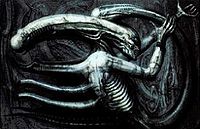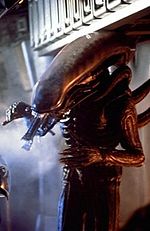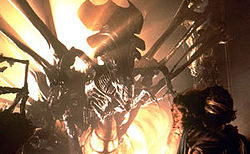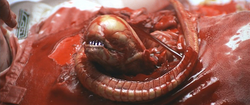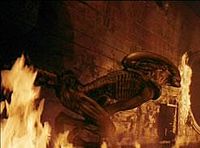- Alien (creature in Alien franchise)
-
This article is about the creature from the Alien film series. For other fictional aliens, see Extraterrestrial life in popular culture. For other uses, see Alien (disambiguation).
Alien 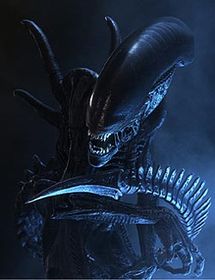
An Alien in Alien vs. PredatorClassification Alien lifeform First appearance Alien Last appearance Aliens vs. Predator: Requiem Created by Dan O'Bannon
Ronald ShusettPortrayed by Bolaji Badejo
Carl Toop
Tom Woodruff, Jr.The Alien (sometimes referred to as a xenomorph)[1][2] is a fictional endoparasitoid extraterrestrial species that is the primary antagonist of the Alien film series. The species made its debut in the 1979 film Alien, and reappeared in its sequels Aliens (1986), Alien 3 (1992), and Alien Resurrection (1997), two crossovers Alien vs. Predator (2004) and Aliens vs. Predator: Requiem (2007), as well as the various literature and video game spin-offs from the series.
Unlike many other recurring enemy extraterrestrial races in science fiction, the Aliens are not an intelligent civilization, but predatory creatures with no higher goals than the propagation of their species and the destruction of life that could pose a threat. Like wasps or termites, Aliens are eusocial, with a single fertile queen breeding a caste of warriors. The Aliens' biological life cycle, in which their offspring are violently implanted inside living hosts before erupting from their chests, is in many ways their signature aspect. Their design deliberately evokes many sexual images, both male and female, to illustrate its blurring of human sexual dichotomy.
The Alien design is credited to Swiss surrealist and artist H. R. Giger, originating in a lithograph called Necronom IV and refined for the series' first film, Alien. The species' design and life cycle have been extensively added to throughout each film.
Contents
Concept and creation
The script for the 1979 film Alien was initially drafted by Dan O'Bannon and Ronald Shusett.[3] Dan O'Bannon drafted an opening in which the crew of a mining ship are sent to investigate a mysterious message on an alien planet. He eventually settled on the threat being an alien creature; however, he could not conceive of an interesting way for it to get onto the ship. Inspired after waking from a dream, Shusett said, "I have an idea: the monster screws one of them,"[3] planting its seed in his body, and then bursting out of his chest. Both realized the idea had never been done before, and it subsequently became the core of the film.[3] "This is a movie about alien interspecies rape," O'Bannon said on the documentary Alien Evolution, "That's scary because it hits all of our buttons."[4] O'Bannon felt that the symbolism of "homosexual oral rape" was an effective means of discomforting male viewers.[5]
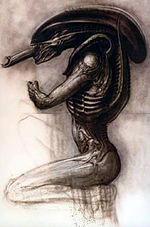 Giger's Alien design, inspired by his earlier painting Necronom IV, for the film Alien
Giger's Alien design, inspired by his earlier painting Necronom IV, for the film Alien
The title of the film was decided late in the script's development. O'Bannon had quickly dropped the film's original title, Star Beast, but could not think of a name to replace it. "I was running through titles, and they all stank", O'Bannon said in an interview, "when suddenly, that word alien just came out of the typewriter at me. Alien. It's a noun and it's an adjective."[3] The word alien subsequently became the title of the film and, by extension, the name of the creature itself.
Prior to writing the script to Alien, O'Bannon had been working in France for Chilean cult director Alejandro Jodorowsky's planned adaptation of Frank Herbert's classic science-fiction novel Dune. Also hired for the project was Swiss surrealist artist H. R. Giger. Giger showed O'Bannon his nightmarish, monochromatic artwork, which left O'Bannon deeply disturbed. "I had never seen anything that was quite as horrible and at the same time as beautiful as his work," he remembered later.[6] The Dune film collapsed, but O'Bannon would remember Giger when Alien was greenlit, and suggested to director Ridley Scott that he be brought on to design the Alien, saying that if he were to design a monster, it would be truly original.[3]
After O'Bannon handed him a copy of Giger's book Necronomicon, Scott immediately saw the potential for Giger's designs, and chose Necronom IV, a painting Giger completed in 1976, as the basis for the Alien's design, citing its beauty and strong sexual overtones. That the creature could just as easily have been male or female was also a strong factor in the decision to use it. "It could just as easily fuck you before it killed you", said line producer Ivor Powell, "[which] made it all the more disconcerting."[4] Fox was initially wary of allowing Giger onto the project, saying that his works would be too disturbing for audiences, but eventually relented. Giger initially offered to completely design the Alien from scratch, but Scott mandated that he base his work on Necronom IV, saying that to start over from the beginning would be too time-consuming. Giger signed on to design the adult, egg and chest-burster forms, but ultimately also designed the alien planetoid LV-426 and the Space Jockey alien vessel.[3]
Giger conceived the Alien as being vaguely human but a human in full armor, protected from all outside forces. He mandated that the creature have no eyes, because he felt that it made them much more frightening if you could not tell they were looking at you.[4] Giger also gave the Alien's mouth a second inner set of Pharyngeal jaws located at the tip of a long, tongue-like proboscis which could extend rapidly for use as a weapon. His design for the creature was heavily influenced by an aesthetic he had created and termed biomechanical, a fusion of the organic and the mechanic.[4] His mock-up of the Alien was created using parts from an old Rolls Royce car, rib bones and the vertebrae from a snake, molded with plasticine. The Alien's animatronic head, which contained 900 moving parts, was designed and constructed by special effects designer Carlo Rambaldi.[3] Giger and Rambaldi would both go on to win the 1980 Academy Award for Visual Effects for their design of the Alien.[7]
Scott decided on the man-in-suit approach for creating the creature onscreen. Initially circus performers were tried, then multiple actors together in the same costume, but neither proved scary. Deciding that the creature would be scarier the closer it appeared to a human, Scott decided that a single, very tall, very thin man be used. Scott was inspired by a photograph of Leni Riefenstahl standing next to a 6'4" (1.94 m) Nubian.[8] The casting director found 7'2" (2.18 m), rail-thin graphic designer Bolaji Badejo in a local pub. Badejo went to tai chi and mime classes to learn how to slow down his movements.[3]
Name
This creature has no specific name, and has been referred to most often onscreen, and in the credits of each film, simply as the Alien. It was called an alien, an organism, and Kane's son in the first film. It has also been referred to as a creature,[1] a serpent,[9] a beast,[2] a dragon,[2] a monster,[1] or simply, a thing.[10] The term xenomorph (lit. "alien form"—from Greek xeno- or "strange" and -morph, shape) was used by the character Lieutenant Gorman in Aliens[1] and by Ellen Ripley in a deleted scene from Alien 3.[2] This term has been adopted by fans[11] and used in merchandising[12] as a convenient name. The species' binomial names are given in Latin as either Internecivus raptus (meant as "murderous thief") in the Alien Quadrilogy DVD or Lingua foeda acheronsis (meant as "foul tongue from Acheron")[13] in some comic books.[14] The main Alien from Alien vs. Predator is listed in the credits as "Grid", after a grid-like wound received during the film.[9]
Characteristics
Continuing advancements made in the field of special effects technology as the series progressed have led to numerous variations in the creature's design, including varying numbers of fingers and limb joints and varying head design.
Appearance
When standing upright, the Aliens are vaguely bipedal in form, though they adopt a more hunched, quadrupedal stance when walking or sprinting. They have a skeletal, biomechanical appearance and are usually colored in muted shades of black, blue or bronze. Aliens do not radiate heat, as their body heat matches the ambient temperature of the environment in which they are found.[1][9] In most of the films, adult Aliens have the ability of running and crawling along ceilings and walls.[1][2] They have great physical strength, having been shown to be capable of breaking through welded steel doors.[1]
Aliens have segmented, blade-tipped tails. The sharp tip was initially a small, scorpion-like barb,[10] but from Aliens onwards the blade design increased in size and changed in appearance to more closely resemble a slashing weapon.[1][9] From Alien Resurrection onwards, the tails have a flat ridge of spines at the base of the blade. This was introduced to help them swim convincingly,[15] and was left intact in the subsequent cross-overs. The original shooting script for Aliens and the novelization both featured a scene in which Lieutenant Gorman is "stung" by the barb tail and rendered unconscious.[16] In the final cut of the movie, Gorman is knocked out by falling crates. As a weapon, the strength of the tail is very effective, having been shown to be strong enough to impale and lift a Predator with seemingly little effort. They are also adept at using their tails as blunt weapons, sometimes to deadly effect, as seen in Alien.
They have elongated, cylindrical skulls, but possess no visible eyes, though in the original Alien film, the top of the creature's head was translucent, with empty eye sockets of human appearance visible within. This element was re-used for the "Predalien" 29 years later. How the creatures see is uncertain. In Alien 3, a fisheye lens was used to illustrate the Alien's point of view. In the novelization of the movie Alien, the creature is held mesmerized by a spinning green light for several minutes. In Aliens, the adult creatures have a more textured head rather than a smooth carapace. In the commentary for Aliens, it was speculated that this was part of the maturation of the creatures, as they had been alive far longer than the original Alien. The smooth design of the carapace would be used again in Alien 3 and Alien Resurrection, although made narrower with a longer muzzle and more prominent chin. This design would be kept in Alien versus Predator,[17] and abandoned in Aliens vs. Predator: Requiem in favor of the ribbed design. The Aliens' inner jaws are powerful enough to smash through bone and metal.[9]
Throughout their appearances, human-spawned Aliens have been shown to have a fluctuating number of fingers. In Alien, the creature has webbed, six fingered hands. In Aliens, the number of fingers is reduced to three (two "paired" and a single, opposable thumb), and they are shown to be much longer and more skeletal. In Alien Resurrection, the number of digits is increased to four, with two long middle fingers and a pair of thumbs. This design is kept in the Alien vs. Predator films, though the hands were made bulkier in order to make the Aliens seem more formidable against the Predators.[18]
Aliens have been alternately portrayed as both plantigrade and digitigrade organisms, usually in accordance to their host. Human-spawned Aliens were usually portrayed as having humanoid hind limbs, while in Alien 3, the featured Alien sported double-jointed legs due to its quadrupedal host. This characteristic would be continued in Alien Resurrection for the human-spawned Aliens. Tom Woodruff, who had previously played the "dog-alien" in Alien 3, described the human-spawned Aliens in Resurrection as feeling more like a dog than the previous creature, despite having been born from human hosts.[19] The human spawned Alien warriors would revert back to a plantigrade posture in Alien vs. Predator.
Blood and secretions
Alien blood is an extremely potent acid and is capable of corroding on contact almost any substance with alarming speed. It is dull yellowish-green in color, and seems to be pressurized inside the body so that it spurts out when punctured. Shusett suggested the idea that the creature have acid blood as a plausible means to make the creature "unkillable"; if one were to use traditional firearms or explosives to attack it, its blood would eat through the hull of the ship.[20] The Alien novelization suggests that, at least at the "facehugger" stage, the acid is not blood but a fluid maintained under pressure between a double layer of skin.[21] In later films in the series, the Aliens are shown to be conscious of the effects of their acidic blood, and even use it to their advantage: In Alien Resurrection, two Aliens escape a cage by killing a fellow Alien so its acid eats through the cage floor; in Aliens vs. Predator a queen being held by chains apparently instructs several Aliens to slash and cut her, thus corroding the chains. In the Aliens vs. Predator: Requiem documentary: "Science of the Alien", it is theorized that the Aliens' acid blood could be some type of "hydrosulphuric acid" composition due to its corrosiveness and the conspicuously toxic effects on living human tissue. The documentary also speculates that Aliens are immune to their own acidic and toxic liquids due to a endobiological build-up similar to the human stomach's ability to protect itself from its digestive fluids. The documentary takes this theory one step further and speculates that the Alien organisms' protection system against its own toxic hydrosulphuric acid is protecting the rest of the organism with what is basically a bio-organically produced Teflon isolation.[22] In the film Alien vs. Predator this is shown to be the case, as a Predator uses Alien chitin to make armor for Alexa that protects her from their blood.
Aliens can produce a thick, strong resin (secreted from their maws, giving them the look of a slavering beast) that they use to build their hives and to cocoon their victims, and they can use the walls of their hives as camouflage. In the original Alien, the facehugger is shown to be able to "spit" acid, melting the faceplate of Kane's helmet and allowing the creature immediate access to the inside. This ability is also exhibited by adult Aliens in Alien 3 and Alien Resurrection; much like a spitting cobra, they use it to blind and immobilize their victims.[2][23]
Intelligence and communication
Events on the LV-426 colony and USM Auriga showed that the species excels at observational learning and problem solving.[1][23] In both cases, the Aliens managed to learn how to operate the machinery of their mechanized environments at a very basic level. On LV-426, the Aliens were able to cut the power from a section of the complex to allow themselves access to the humans. The queen figured out to board the elevator simply by observing Ripley and Newt escaping in the one beside it, as Ripley had called for both elevators and boarded the first one to arrive. The novelisation of the film notes that the queen establishing her 'nest' at the base's main power plant could equally be the result of her selecting the warmest part of the base to make her nest or her deliberately selecting a location where any attackers would be unable to destroy her without destroying the entire facility. In the director's commentary for Aliens, James Cameron noted that the creatures in Aliens had been alive for far longer than the Alien in the original, and so had more time to learn how to manipulate machinery.[24] On the USM Auriga, they were able to use blood from another Alien to melt through their enclosure and escape, with the Aliens in the Antarctic temple using a similar strategy to free the queen from her chains. With the exception of the "Newborn", Aliens have demonstrated little actual emotion, save for self preservation and maternal instincts toward their eggs.
Life cycle
Aliens are depicted as eusocial life-forms with a defined caste system which is ruled over by a queen.[1][9][23] Their life cycle comprises several distinct stages: they begin their lives as an egg, which hatches a parasitoid larval form known as a facehugger, which then attaches itself to a living host by, as its name suggests, latching onto its face. In the Alien 3 novelization, Ripley commented that this parasitoid would not likely be able to use a host any smaller than a cat, or as large as an elephant.
The facehugger then "impregnates" the host with an embryo known as a "chestburster,"[25] which, after a gestation period of several hours, erupts violently from the host's chest resulting in the death of the host.
The chestburster then matures to an adult phase within a few hours, shedding its skin and replacing its cells with polarized silicon. Due to Horizontal gene transfer during the gestation period, the Alien also takes on some of the basic physical attributes of the host from which it was born, allowing the individual alien to adapt to the host's environment.
Queen
Queen Aliens are significantly larger and stronger than the warriors, approximately 4.5 metres (15 ft) tall.[26] Their body structure differs also, having two pairs of arms, one large and one small. The queen's head is larger than other adult Aliens and is protected by a large, flat crest, like a crown, and they vary from queen-to-queen. Unlike other Aliens, the queen also has high heel protrusions from its feet.
Egg-laying Alien queens possess an immense ovipositor on their lower torso, similar to a queen termite's. Unlike insect queens, there appears to be no need for drones to fertilize an Alien queen's eggs.[9][23] When attached to its ovipositor, the queen is supported by a "biomechanical throne"[27] that consists of a lattice of struts resembling massive insect legs.
In the initial cut of Alien, the Alien possessed a complete life cycle, with the still-living bodies of its victims converted into eggs. However, the scene showing this final stage was cut for reasons of pacing, leaving the ultimate origin of the eggs obscure. This allowed Aliens director James Cameron to introduce a concept he had initially conceived for a spec script called Mother,[24] a massive mother Alien which laid the eggs and formed the basis for the Aliens' life cycle. Cameron conceived the Queen as a monstrous analogue to Ripley's own maternal role in the film.[24] In that vein, some critics[28] have compared it to Grendel's mother.[29]
The design of the queen was created by Cameron in collaboration with special effects artist Stan Winston, based upon an initial painting Cameron had done at the start of the project. The Winston Studio created a test foam core queen before constructing the full hydraulic puppet which was used for most of the scenes involving the large Alien. Two people were inside working the twin sets of arms and puppeteers off-screen worked its jaws and head. Although at the end of the film the queen was presented full-body fighting the power-loader, the audience never sees the legs of the queen, save those of the small-scale puppet that appears only briefly. In Aliens, Cameron used very selective camera-angles on the queen, using the 'less is more' style of photography. Subsequently the movie won an Oscar for Visual Effects.[30] An adult queen was to reappear in Alien Resurrection. The original mechanical head previously used in Aliens was provided by Bob Burns. It was repainted with a blend of green and brown, giving it a shimmering, insect-like quality.[18] This color concept would be abandoned in Alien versus Predator in favour of the original black color scheme.[18]
In the climax of the 2004 film Alien vs. Predator the queen's basic design was altered to make it more "streamlined" in appearance and its over-all size was increased to 6 meters (20 feet) tall. Other changes include the removal of the "high-heel" protrusions on its legs, including additional spines on its head and making its waist thinner because there was no need for puppeteers inside its chest. The animatronic laying queen had 47 points of hydraulic motion.[18]
Aliens vs. Predator: Requiem (2007) introduced a younger form of the full grown queen, albeit with traits inherited from its Predator host. Recalling the facehugger's method of embryo implantation, the Predalien uses its inner mouth to directly deposit multiple chestburster embryos into pregnant female hosts.[31] This is explained by the Brothers Strause as a means of quickly building an army of Aliens before the young queen evolves into its sedentary, egg-laying state.[32]
Egg
The eggs laid by the queen are large, ellipsoidal leathery objects between two to three feet high with a four-lobed opening at the top. As a potential host approaches, the egg's lobes unfold like flower petals, and the parasitic facehugger extracts itself from the egg and attaches itself to the potential host. Giger initially designed the eggs with a much more obviously vaginal appearance, complete with an "inner and outer vulva".[33] The producers complained that Catholic countries would ban the film if the allusion was too strong, so Giger doubled the lobes to four, so that, in his words, "seen from above, they would form the cross that people in Catholic countries are so fond of looking at."[33] The interior of the original egg was composed of "Nottingham lace", which is the lining of a cow's stomach. In the first film, the quick shot of the facehugger erupting from the egg was done with sheep's intestine.[3] Initially the egg remained totally stationary save for the hydraulic movement of the lobes; however, by Alien Resurrection the entire egg was made to ripple as it opened.
Facehugger
A facehugger is the second stage in the Alien's life cycle. It has eight long finger-like legs which allow it to crawl rapidly, and a long tail adapted for making great leaps. These particular appendages give it an appearance somewhat comparable to chelicerate arthropods such as arachnids and horseshoe crabs.
The facehugger is a parasitoid; its only purpose is to make contact with the host's mouth for the implantation process, by gripping its legs around the victim's head and wrapping its tail around the host's neck. Upon making contact, the facehugger tightens its tail around the host's neck in order to render it unconscious through oxygen deprivation. The facehugger then inserts a proboscis down the host's throat, supplying it with oxygen[10] while simultaneously implanting an embryo. Attempts to remove facehuggers generally prove fatal,[1] as the parasitoid will respond by tightening its grip, and the facehugger's acidic blood prevents it from being safely cut away.[10]
Once the Alien embryo is safely implanted, the facehugger detaches and dies.
Giger's original design for the facehugger was a much larger creature with eyes and a spring-loaded tail. Later, in response to comments from the filmmakers, Giger reduced the creature's size substantially.[34] At first Giger assumed that the facehugger would wrap around the outside of the astronaut's helmet, but Scott decided that it would have far more impact if the facehugger were revealed once the helmet was removed. Scott and Giger realised that the facehugger could burn through the helmet's faceplate with its acid blood; subsequent redesigns of the space helmet included a far larger faceplate to allow for this.[35] Dan O'Bannon initially conceived the facehugger as somewhat resembling an octopus, possessing tentacles. However, when he received H. R. Giger's designs, which substituted tentacles with fingerlike digits, he thought Giger's design concept superior. Since no one was available at the time, O'Bannon decided to design the facehugger prop himself. The technical elements of the musculature and bone were added by Ron Cobb. Giger's initial design for the smaller facehugger had the fingers facing forward, but O'Bannon's redesign shifted the legs to the side. When the foam rubber sculpture of the facehugger was produced, O'Bannon asked that it should remain unpainted, believing the rubber, which resembled human skin, was more plausible.[36]
In Alien 3, another addition, a "super-facehugger" that would carry the embryo of the queen Alien, was planned but ultimately dropped.[37] The super-facehugger is briefly glimpsed in the Assembly cut of Alien 3, but not identified as such.[37][38]
Chestburster
After implantation, facehuggers die and the embryo's host wakes up afterwards showing no considerable outward negative symptoms. Symptoms build acutely after detachment of the facehugger, the most common being sore throat, slight nausea, increased congestion and moderate to extreme hunger.[10] In later stages where the incubation period is extended in preparation of a queen birth, symptoms will include a shortness of breath, exhaustion, and hemorrhaging (detectable through biological scanners and present in nosebleeds or other seemingly random bleeding incidents), as well as chest pains inflicted either in lack of chest space due to the chestburster's presence, or even premature attempts to escape the host.[2] The incubating embryo takes on some of the host's DNA or traits, such as bipedalism, quadrupedalism[2] or possessing the mandibles of a Predator[39] and other body structure changes. Over the course of 1–24 hours, indeterminable in some cases, and sometimes up to a week, in the case of some queens, the embryo develops into a chestburster, at which point it emerges, violently ripping open the chest of the host, killing it.
The chestburster was designed by Alien director Ridley Scott and constructed by special effects artist Roger Dicken.[5] Giger had produced a model of a chestburster that resembled a "degenerate plucked turkey"[40] and was far too large to fit inside a ribcage. Much to Giger's chagrin, his model reduced the production team to fits of laughter on sight.[4] Scott drafted a series of alternate designs for the chestburster based on the philosophy of working "back [from the adult] to the child" and ultimately produced "something phallic."[4] The chestburster in the original Alien was armless but arms were added in Aliens to facilitate the creature crawling its way out of its host's corpse.[41] This concept would be abandoned in Alien Resurrection and subsequent films.
Growth and maturity
When a chestburster erupts from the body of its host, it is less than 1 foot (30 cm) tall. However, it soon undergoes a dramatic growth spurt, reaching adult size in a matter of hours; in Alien the chestburster had grown to 2 metres (6.6 ft) in height by the time the Nostromo crew located it again.[42] The chestburster is shown to have molted before reaching maturity.[10] In Aliens vs. Predator: Requiem Alien warriors are shown who are still growing, showing shedding skin. In the unrated cut, the Predalien is shown actively wiping off its final molted skin at the film's start. A shed skin of a growing chestburster is also shown, showing that the creature's final limbs do not grow in the earliest stages.[citation needed]
Alternative forms
Aliens take on various forms depending on the characteristics of their hosts. Most of the Aliens seen to date have been human-spawned, but a number of Aliens born from other hosts have also been seen.
"Dog Alien"
The "Dog Alien" (also jokingly referred to as the "Bambi burster",[37] or "Runner Alien" in the expanded universe stories), was introduced in Alien 3. The creature itself shares the same basic physical conformation and instincts as the other Aliens shown in the previous films, although there are several differences due to the host it was spawned from (a dog in the theatrical cut, an ox in the DVD assembly cut). The Dog Alien in its Chestburster form is a miniature version of the adult, unlike the larva-like human spawned chestbursters. The adult is primarily quadrupedal, has digitigrade hind legs and lacks the dorsal tubes of the human-spawned variety.
Concept and credit controversy
Originally, H. R. Giger was approached on July 28, 1990 by David Fincher and Tim Zinnemann, and was asked to redesign his own creations for Alien 3. Giger's new designs included an aquatic face-hugger and a four-legged version of the adult Alien. Giger said in an interview; "I had special ideas to make it more interesting. I designed a new creature, which was much more elegant and beastly, compared to my original. It was a four-legged Alien, more like a lethal feline – a panther or something. It had a kind of skin that was built up from other creatures – much like a symbiosis." However, when Tom Woodruff and Alec Gillis of Amalgamated Dynamics told Giger that they had their own design, Giger expressed himself as "very upset" and that the creature he had especially designed was his "baby". Even after the production severed contact, Giger continued to fax suggestions to Fincher because of his enthusiasm for the project, and made full-scale drawings and a sculpt of the Alien, all of which were rejected.
David Fincher neglected to inform me that Woodruff and Gillis were also contracted to take care of the redesign of the Alien – I found out much later... I thought I had the job and that Woodruff and Gillis would work from my plans. On their side, they were convinced that it was their job and accepted my 'suggestions' with pleasure. They believed that all my effort was based on a huge love for the matter, because I worked hard even after my contract was over.
Giger would later be angered by the end credits of the released film presenting him as merely the creator of the original creature, and the fact that ADI personnel gave a series of interviews that minimized Giger's contribution. Fox eventually reimbursed Giger, but only after he refused to be interviewed for their behind-the-scenes documentary of Alien 3.
The Academy Awards overlooked Giger's contribution to Alien 3. However, Ridley Scott included Giger's name along with nominees Carlo Rambaldi and Richard Johnson. Fox, at the time Alien 3 was released, pointed out that studios are precluded from submitting nominees in the effects category directly to the Academy. This upset Giger so much that at one point he sent Academy president Karl Malden a fax with this closing comment: "I am under the strong impression that my contribution to the visual effects of the nominated movie has been intentionally suppressed", signing the letter with a large black pentagram.
Giger however would comment that he thought the resulting film was "okay" and that the Alien was "better than in the second film."[43]
Newborn
In Alien Resurrection, due to significant genetic tampering in an attempt to recover DNA from the deceased Ellen Ripley and the Alien Queen within her, the resulting cloned Aliens show a number of minor human traits. The cloned Queen inherits a womb, and as a result it ceases to lay eggs and gives birth to a humanoid mutant. Physically, the human-Alien Newborn is very different from its brethren, being larger, with pale, translucent skin, a skull-shaped face with eyes, a human tongue and complete absence of a tail. The Newborn fails to bond with its Alien Queen mother, and kills it. Instead, the Newborn sees the Ripley clone as a surrogate parent.
The Newborn creature was originally scripted by Joss Whedon as being an eyeless, ivory-white quadruped with red veins running along the sides of its head. It had an inner jaw, with the addition of a pair of pincers on the sides of its head. These pincers would have been used to immobilise its prey as it drained it of blood through the inner jaw. The creature was also meant to rival the Queen in size.[44] Jean-Pierre Jeunet later asked ADI to lean towards making the human-Alien hybrid, known as the Newborn, more human than Alien. The Newborn's eyes and nose were added to improve its expressions to make it a character, rather than just a "killing machine", and give it depth as a character. Jeunet was adamant about the Newborn having genitalia, a mix of both sexes. However, Fox was uncomfortable and even Jeunet felt "even for a Frenchman, it's too much."[15] The genitalia were digitally removed in post-production. The Newborn animatronic required nine puppeteers and was the most complex animatronic in the film.[15]
Predalien
This variation is the result of a facehugger impregnating a Predator. The "Predalien" was first depicted in a painting by Dave Dorman, and subsequently featured in the Aliens versus Predator comics and games. A Predalien chestburster debuts in the final scene of Alien vs. Predator, but it is not until Aliens vs. Predator: Requiem that an adult hybrid makes its first movie appearance.
The Predalien shares many characteristics with its host, such as long hair-like appendages, mandibles, skin color and similar vocalizations. It is a large, bulky creature, and possesses physical strength greater than that of human-spawned Aliens. Like human-born Aliens, it is also shown to be stronger than its host species, as evidenced by its ability to pin, push, and knock a Predator away with ease. It also possessed the ability to impregnate human hosts with multiple Alien embryos.
Cultural impact
In the years since the release of Alien, the Alien has become one of the world's most recognized movie monsters and a pop-cultural icon. In 2003, the Alien was voted as the 14th most memorable screen villain by the American Film Institute.[45] Blondie co-founder Chris Stein, who is a friend of Giger, pondered in an interview:
I'd like to see someone even vaguely compile how many versions of the Alien are floating around the world in models and stuff; there must be close to 100,000–little toys, things. All the Japanese horror comics just plunder his style.[46]
Examples of Alien-inspired works include the classic video games Contra[47] and Metroid.[48]
The Aliens have appeared in many crossovers (including a large number of intercompany crossovers) in comic books and other media such as novels, toys, and video games. Crossovers include encounters with Terminators, Judge Dredd, Green Lanterns, Batman, and Superman. The largest of these crossovers is the Alien vs. Predator franchise, in which the Aliens battle the Predators. This was an idea that came to comic book artist Chris Warner in early 1989. He and other people at Dark Horse Comics were trying to come up with a good character combo for a new comics series. Dark Horse had been publishing Aliens comic book under license from 20th Century Fox since 1987. In 1990, the first depiction of the idea in film appeared in Predator 2, when an Alien skull, sculpted by Kevin Hudson,[41] appeared as one of the trophies in the Predator spacecraft.
See also
References
Citations
- ^ a b c d e f g h i j k James Cameron (writer and director) (1986). Aliens (DVD). 20th Century Fox.
- ^ a b c d e f g h Vincent Ward (writer) and David Fincher (director) (1992). Alien 3 (DVD). 20th Century Fox.
- ^ a b c d e f g h i Star Beast, the Alien Quadrilogy boxset
- ^ a b c d e f Alien Evolution, in the Alien Quadrilogy box set
- ^ a b Alien Woman: The Making of Lt Ellen Ripley Ximena Gellardo, 2006
- ^ Paul Scanlon, Michael Gross (1979). The Book of Alien. WH Allen & Co.
- ^ Awards for Alien at the Internet Movie Database
- ^ HR Giger (1979). HR Giger's Alien. Sphinx. p. 60.
- ^ a b c d e f g Paul W. S. Anderson (writer/director) (2005). Alien vs. Predator (DVD). 20th Century Fox.
- ^ a b c d e f Dan O'Bannon, Ronald Shusett (writers) and Ridley Scott (director) (1979). Alien (DVD). 20th Century Fox.
- ^ "planetavp". Archived from the original on 2008-02-24. http://web.archive.org/web/20080224220615/http://www.planetavp.com/al/Biology/LifeCycle/index.htm. Retrieved 2008-02-29.
- ^ "Forbiddenplanet.co.uk". http://www.forbiddenplanet.co.uk/index.php?main_page=product_info&products_id=40657. Retrieved 2008-02-29.
- ^ With acheronsis instead of acheronensis, acherontea or acheruntica.
- ^ The comic book Aliens versus Predator versus The Terminator includes the binomial name Linguafoeda acheronsis.
- ^ a b c Unnatural Mutation – Creature Design, Alien Quadrilogy, 2003, 20th Century Fox
- ^ PlanetAVP. Retrieved February 23, 2006.
- ^ Gillis, Alec & Woodruff, Tom (2004). AVP: Alien vs Predator: The Creature Effects of ADI. London: Titan Books. p. 128. ISBN 1-84576-004-2.
- ^ a b c d Alec Gillis and Tom Woodruff Jr (2004). Alien vs. Predator: The Creature Effects of ADI.
- ^ Hochman, David (1997-12-05). "Beauties and the Beast". Entertainment Weekly. http://www.ew.com/ew/article/0,,290562,00.html. Retrieved 2008-01-31.
- ^ Ronald Shusett in The Alien Saga; Alien Legacy DVD box set
- ^ Foster, Alan Dean; O'Bannon, Dan (1979). Alien. Macdonald and Jane's. ISBN 0-354-04436-2
- ^ [Shane Salerno (writer) Colin and Greg Strause (directors). (2008). Aliens vs. Predator: Requiem [DVD]. 20th Century Fox.]
- ^ a b c d Joss Whedon (writer) and Jean-Pierre Jeunet (1997). Alien Resurrection (DVD). 20th Century Fox.
- ^ a b c Aliens, film commentary, Alien Quadrilogy box set
- ^ The terms "facehugger" and "chestburster" date at least as far back as The Book of Alien and HR Giger's Alien—behind-the-scenes scrapbooks composed the year of the original film's release—and are used frequently by the film's cast and crew in retrospect.
- ^ Sideshowtoy. Retrieved February 15, 2006.
- ^ James Cameron, Alien Evolution: Aliens
- ^ The Alien Trilogy: A New Beowulf
- ^ Alien Queen in Cameron's Aliens (1986).
- ^ Awards for Aliens at the Internet Movie Database
- ^ "The bellybursters were actually in the first draft that Colin and I read...They had the bellybursters ... caused by an alien warrior, ...We actually made it the Predalien that was reproducing in this fashion"--Greg Strause, "AvP-R: Preparing for War: Development and Production" featurette, from the Aliens vs. Predator: Requiem Region 1 Extreme Unrated Set DVD
- ^ "Basically the Predalien's kind of a baby queen-there's a phase in between warrior alien and full-blown queen...they do this thing with embryo implantation.. the idea with that was; how does a baby queen quickly form her own little mini-drone army to get the hive built before she evolves into the final state where she can't completely defend herself?"--Colin Strause, "AvP-R: Preparing for War: Development and Production" featurette, from the Aliens vs. Predator: Requiem Region 1 Extreme Unrated Set DVD
- ^ a b Giger p. 46
- ^ HR Giger, The Beast Within: The Making of Alien, Alien Quadrilogy Box-set
- ^ Giger 52
- ^ Dan O'Bannon, audio commentary, Alien, from the Alien Quadrilogy DVD set
- ^ a b c Alien3: Adaptive Organism: Creature Design, from the Alien Quadrilogy boxset.
- ^ Alien3: Assembly cut
- ^ Shane Salerno (writer) Colin and Greg Strause (directors) (2008). Aliens vs. Predator: Requiem (DVD). 20th Century Fox.
- ^ Giger p. 56
- ^ a b Jody Duncan & James Cameron (2007). The Winston Effect: The Art and History of Stan Winston Studio. London: Titan. p. 336. ISBN 1-84576-150-2.
- ^ In Aliens Ripley claims that the creature killed the entire crew in 24 hours, so the growth stage must be under 1 day
- ^ "The Official Website". HR Giger. http://www.hrgiger.com/frame.htm. Retrieved 2009-03-02.
- ^ "Alien Resurrection (1997) – Trivia". Imdb.com. http://www.imdb.com/title/tt0118583/trivia. Retrieved 2009-03-02.
- ^ "AFI's 100 YEARS...100 HEROES & VILLAINS". American Film Institute. Archived from the original on 2007-10-23. http://web.archive.org/web/20071023071414/http://www.afi.com/tvevents/100years/handv.aspx. Retrieved 2008-02-25.
- ^ Romy Ashby (2000). "The Talented Mr Giger". space.com. http://www.space.com/sciencefiction/movies/giger_000330.html. Retrieved 2008-02-25.
- ^ "History of Contra". Gaming Target. http://www.gamingtarget.com/article.php?artid=5592. Retrieved 2008-02-25.
- ^ "IGN Presents The History of Metroid". IGN. http://uk.games.ign.com/articles/815/815011p1.html. Retrieved 2008-03-16.
Bibliography
- Alien – Released on May 25, 1979 – On-line script. Retrieved March 2, 2007.
- Aliens – Released on June 18, 1986 – On-line script. Retrieved March 2, 2007.
- Alien 3 – Released on May 22, 1992 – On-line script. Retrieved March 2, 2007.
- Alien: Resurrection – Released on November 26, 1997 – On-line script. Retrieved March 2, 2007.
- Goldman, Willie. "Sideshow Collectibles, Inc.". HAIL to THE QUEEN. http://www.sideshowtoy.com/cgi-bin/category.cgi?category=082504alien2. Retrieved 2006-02-15.
- Nathan. "PlanetAVP.com". Alien universe. http://www.planetavp.com/amr/. Retrieved 2006-02-15.
- Internet Movie Database. "IMDb.com". Awards for Aliens. http://www.imdb.com/title/tt0090605/awards. Retrieved 2006-02-17.
- Unknown author (Last updated 2002). "Alien Collectors Homeworld". Xenomorph.org. http://www.Xenomorph.org/. Retrieved 2006-02-18.
- Unknown author. "Predalien". Predalien information. http://www.predalien.com/. Retrieved 2006-02-18.
- Aliens versus Predator (computer game).
- Aliens versus Predator 2 (computer game).
- Aliens Colonial Marines Technical Manual, HarperCollins 1996, ISBN 0-06-105343-0.
- Aliens: A Comic Book Adventure (computer game) [1]
Categories:- Alien (franchise) characters
- Alien vs. Predator characters
- Horror film characters
- Science fiction film characters
- Fictional extraterrestrial characters
- Fictional extraterrestrial life forms
- Fictional warrior races
- Fictional superorganisms
- Fictional characters introduced in 1979
Wikimedia Foundation. 2010.

